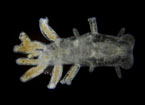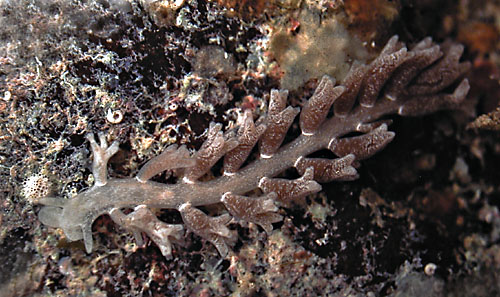_______________
Additional Photos

young, 1.1 mm

|
Embletonia gracilis Risbec, 1928

Maximum Size: 20 mm.
Identification:
The
body
of this unique dendronotid is extremely long and narrow with
a single row of widely-spaced bifid cerata on each side. The cerata
split again at the tips in older animals. The body and cerata are translucent
white, dusted with opaque white flecks and the cerata range from cream
to peach to brown depending on the food source. There is a white ring
at the
base of each ceras where it attaches to the body. Unlike most other
dendronotids, it lacks rhinophoral sheaths.
Natural History:
Embletonia gracilis
is rarely seen due to its small size and cryptic coloration. It has
been found in moderately protected locations on the undersides of rocks
from 9-25 m (30-82 ft). It reportedly feeds on campanularid hydroids
and, like many aeolids, stores the nematocysts in sacks at the tips of
its cerata. (Baba & Hamatani, 1963)
When at
rest, its
body is fully extended, but it contracts and may autotomize its cerata
when disturbed.
Distribution:
Maui, Oahu, Kauai and Midway: widely distributed in the Indo-Pacific; also in
the eastern Pacific.
Taxonomic notes:
This
species
was listed as Embletonia
gracile in Kay, 1979, Gosliner, 1980 and Bertsch & Johnson, 1981. It was first
reported from Hawaii in Edmondson, 1946.
The name means "slender." There's some chance that the juvenile may be different.
Photo: PF: 20
mm: Molokini Islet, Maui; April 9, 1994.
Observations and comments:
Note
1: ( )
|
|


